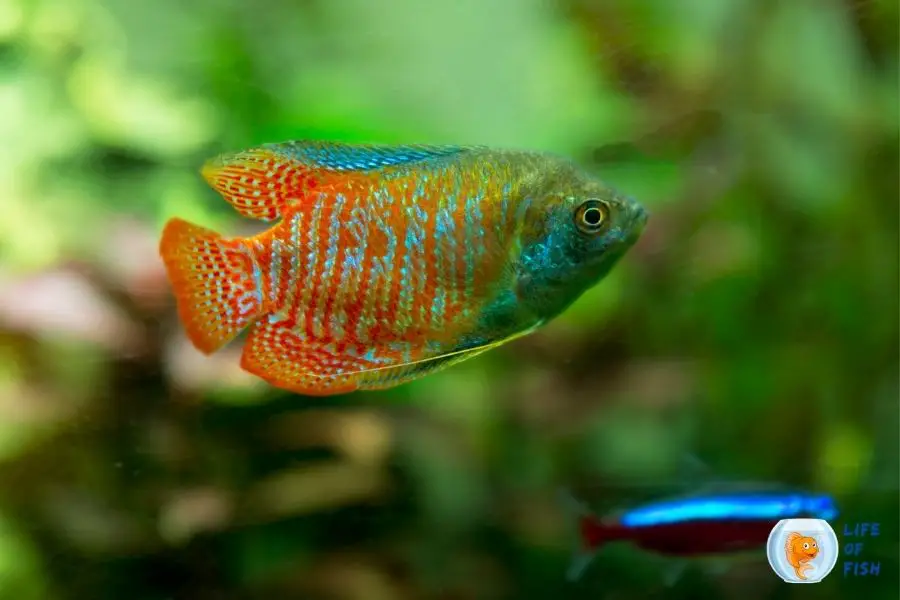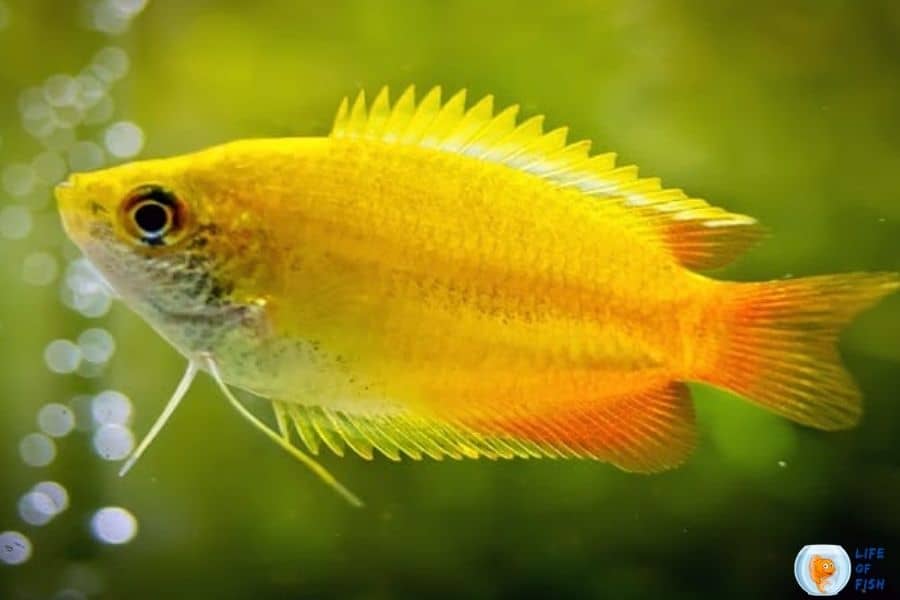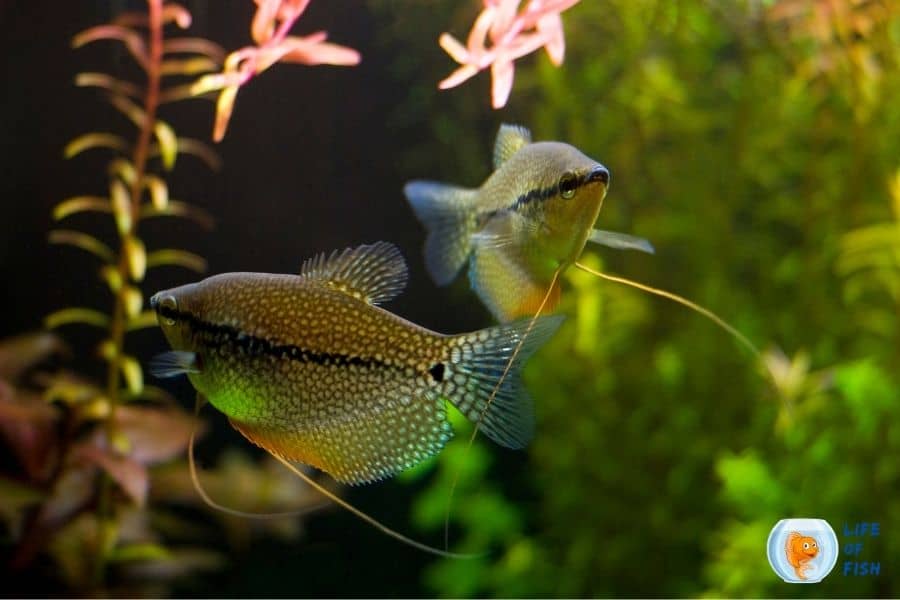Gouramis are popular freshwater fish loved for their unique labyrinth organ allowing them to gulp air from the surface. But some aquarists are surprised when their gouramis show aggression by bullying tankmates.

While most gourami species exhibit some confrontational behaviors, excessive aggression like relentless chasing, nipping fins, or flaring gills indicates an underlying issue with the tank environment or fish.
Let’s explore why are gouramis aggressive, and what aquarists can do to resolve aggression issues humanely.
Underlying Reasons Why are Gourami Aggressive
Jump To
While gouramis display some natural territorial behaviors, excessive non-stop aggression usually stems from improper tank conditions including:
- Inadequate Tank Size: Bullying often results from cramped spaces, where gouramis struggle to establish distinct territories.
- Underpopulated Tanks: Gouramis are social fish that can get stressed and reactive without a proper school size of 5-6 of their own species.
- Poor Water Quality: Ammonia and nitrite spikes plus insufficient water changes provoke aggression as gouramis feel irritated.
- Improper Water Parameters: Unsuitable temperature, pH, hardness, etc. outside the species’ natural range can lead to bullying behaviors.
- Overcrowding: Too many gouramis or other fish packed into a small tank invariably increases hostility as competition for resources mounts.
- Hunger: Insufficient food leads to fighting over any morsels introduced. Feeding inadequate varieties can also cause aggression.
- Breeding Behaviors: Males bully females they wish to breed with and battle other males encroaching on their nesting territories.
- Incompatible Tankmates: Fin nippers like tiger barbs elicit defensive attacks. Slow-moving fish seem easy prey.
By identifying and resolving the specific triggers causing heightened aggression in a particular tank, gourami bullying can be significantly reduced.
Recognizing Aggressive Gourami Behaviors
Gouramis display behaviors serving to intimidate tankmates and establish dominance. Watch for these bullying tactics:
- Flaring gills to appear larger and more menacing.
- Spreading fins while arching body to seem bigger.
- Staring down or circling other fish to herd them.
- Charging aggressively at tankmates who encroach on claimed territory.
- Relentless chasing, nipping fins and bumping other fish.
- Guarding food and prime habitat spots from other tank residents.
Take note if any gouramis seem to be initiating the majority of confrontations while others shy away. The frequency and intensity of these behaviors gives insight into the aggression level at play.

6 Ways to Curb Gourami Aggression and Bullying
If your gouramis show excessive hostility beyond normal territorial spats, try these remedies:
- Add more plants and hides – Break up sight lines and create clear zones and barriers with thick vegetation and caves. This allows each fish to establish an individual domain.
- Rearrange tank layout – Shift decor, plants, rocks etc weekly to disrupt developing territorial mindsets. New environments keep fish focused on exploration, not bullying.
- Use tank dividers – In a large tank, divide aggressive fish for a time-out period. Floating plastic grids work well for this. Reintegrate cautiously after a couple weeks.
- Supplement diet with peas/leafy greens – These fibrous foods curb aggression. Offer a few times per week along with high quality proteins.
- Increase water changes – Aggression often links to water quality. Do 30% weekly changes and test parameters to keep toxins in check. Use activated carbon.
- Add tank dither fish – Active mid-level schooling fish like small rasboras provide distraction targets drawing aggression away from other community fish.
Persistently hostile gouramis may require permanent rehoming or separation from the community for the wellbeing of all fish. Never release pets into the wild.
Tank Setup Tips to Prevent Aggression in Gouramis
While dealing with current aggression is important, optimizing the habitat can curb bullying issues from developing in the first place:
- Select sufficiently large tanks – 40+ gallons for dwarf gouramis, 75+ gallons for larger species.
- Group gouramis in schools of 5-6 of their same species – avoid lone specimens.
- Create broken sight lines with ample plants and hides – provide an individual domain for each gourami.
- Use floating plants to diffuse harsh overhead light which can overstimulate aggression.
- Position spray bars or outflow to break the surface – the noise helps mask hostile behaviors.
- Maintain pristine water quality – test frequently and perform ample water changes.
- Feed a high quality, varied diet to avoid nutrition-related aggression.
Proper initial tank setup goes a long way towards preventing aggressive issues down the road!
With patience and persistent adjustments, aggression can often be resolved without rehoming or euthanizing fish. But in severe cases, it may become the most responsible option.

Frequently Asked Questions About Gourami Aggression
To wrap up, let’s answer some common questions about addressing bullying in gouramis:
Do female gouramis show less aggression than males?
Typically yes, females tend to be less hostile than males focused on establishing breeding territories. But bullying can occur in any gourami if the tank environment elicits stress.
What are some gourami tank mates that can hold their own?
Robust fish like cichlids, larger tetras, silver dollars, and rainbow sharks can handle sporadic gourami aggression. Bottom dwellers like plecos tend to be ignored.
Is adding more plants to a tank enough to curb aggression?
Plants help provide sight breaks but must be combined with appropriate tank size, water quality, schools of gouramis, and environmental enrichment to fully address the underlying stressors causing aggression.
When should I remove a relentlessly aggressive gourami?
If aggression escalates to relentless chasing, fin nipping, or obvious distress in tankmates despite 4+ weeks of habitat adjustments, removing the bully may be needed to protect the health of other fish.
Can I keep a single male gourami alone in a community tank?
Loner gouramis often become stressed and overly aggressive. For success, maintain schools of 5-6 gouramis and optimize tank conditions to avoid hostility.
By understanding the roots of gourami aggression and how to remedy issues, you can curb bullying and enjoy the beauty of these fish in a tranquil community aquarium.
Fostering Peaceful Gourami Communities
With their shimmering colors and bubbly personalities, gouramis can make wonderful additions to community tanks. But allowing aggression to go unchecked jeopardizes their health and that of their tankmates.
Fortunately, simple habitat adjustments and a watchful eye can head off violent behaviors before they become ingrained. With time and effort, your gourami tank can become a flowing, lively ecosystem where all fish coexist in harmony.
We hope this article has provided you some helpful insights on curbing aggression and bullying in gouramis. Let us know if you have any other questions! Wishing you much success in creating a tranquil aquatic community.
Samurai Gourami | How I Care (Without Killing Them) |
Female Honey Gourami | 9 Fascinating Facts You Must Know |
Are Gourami and Cichlids the same? 12 Interesting Facts
